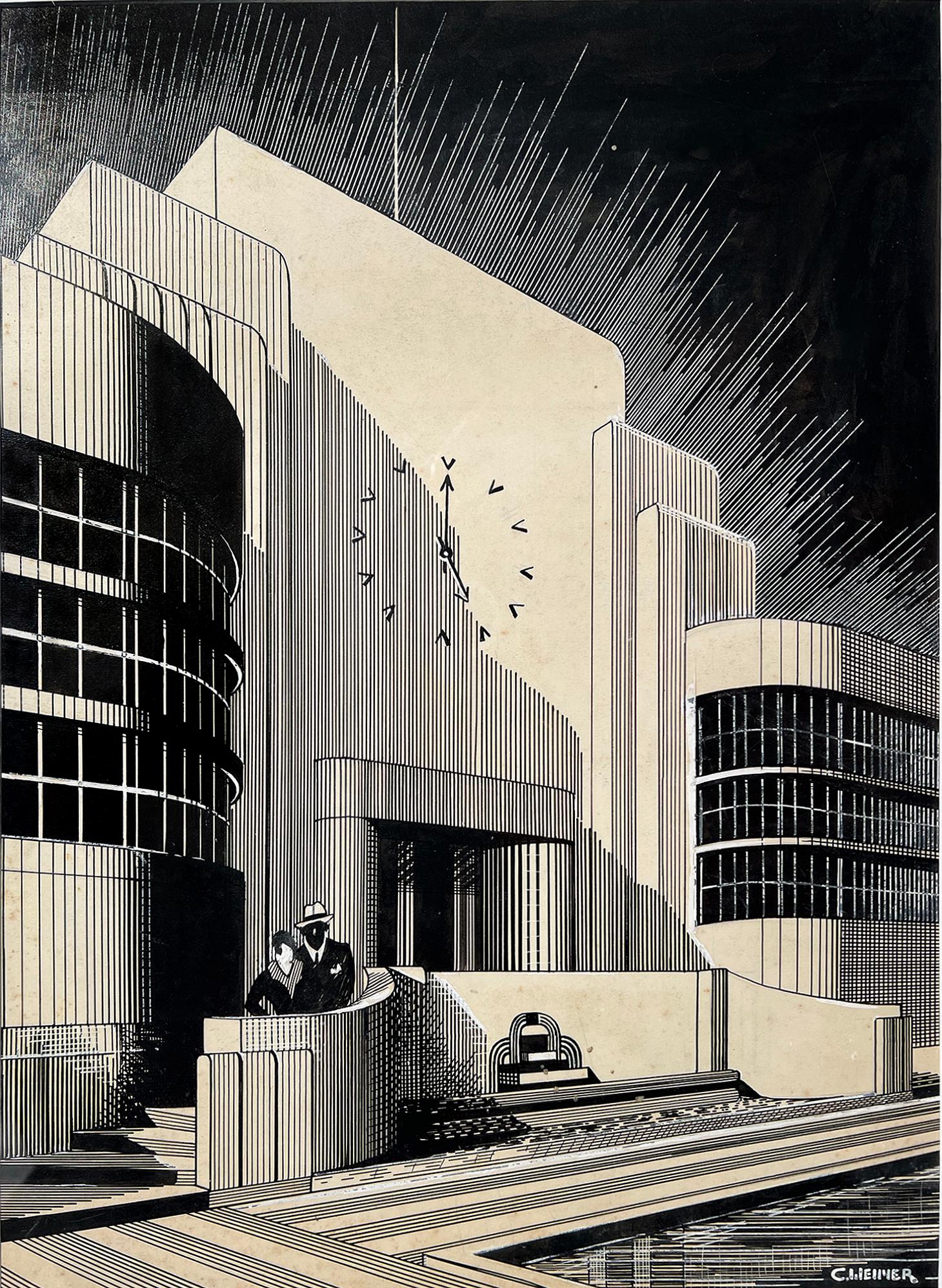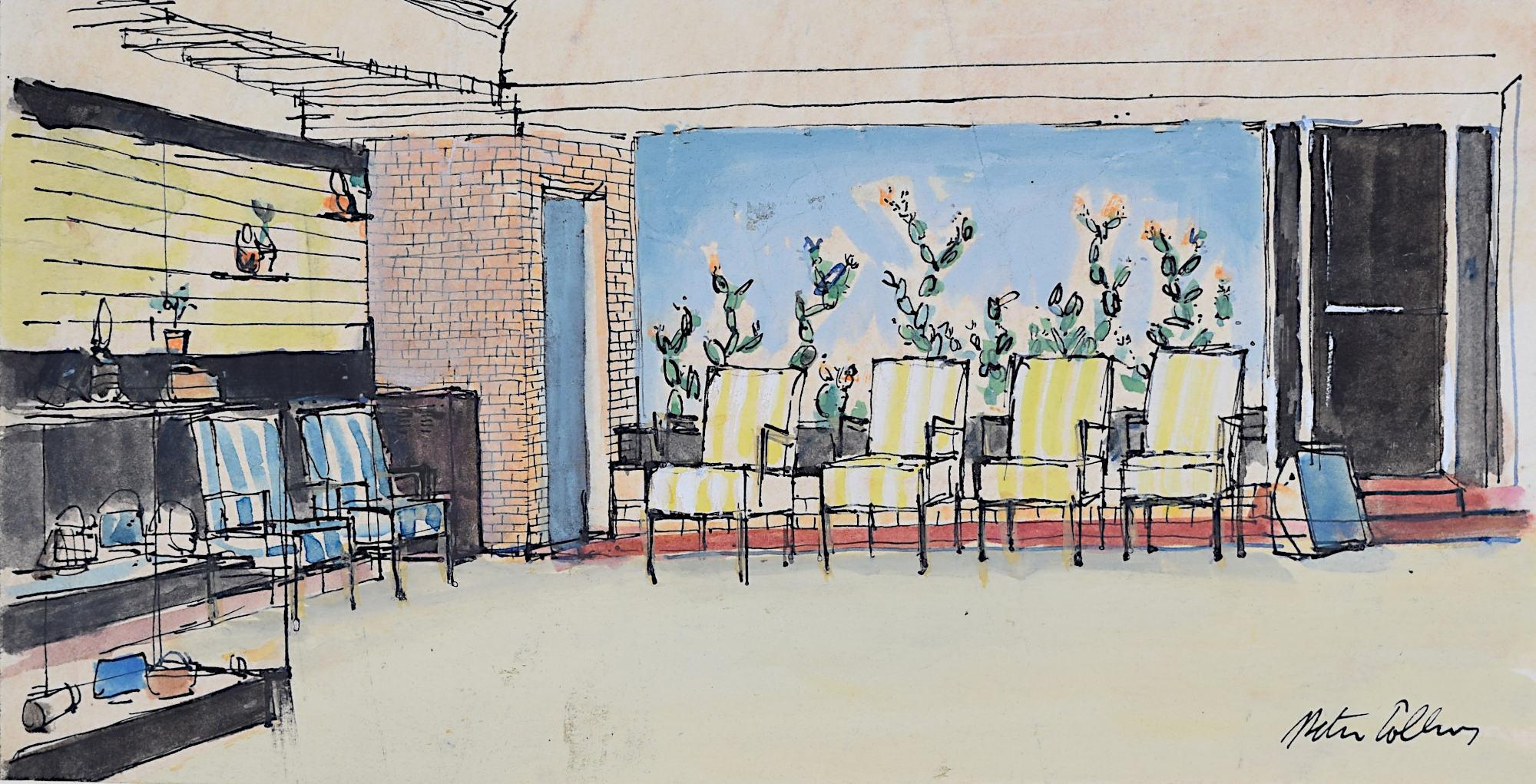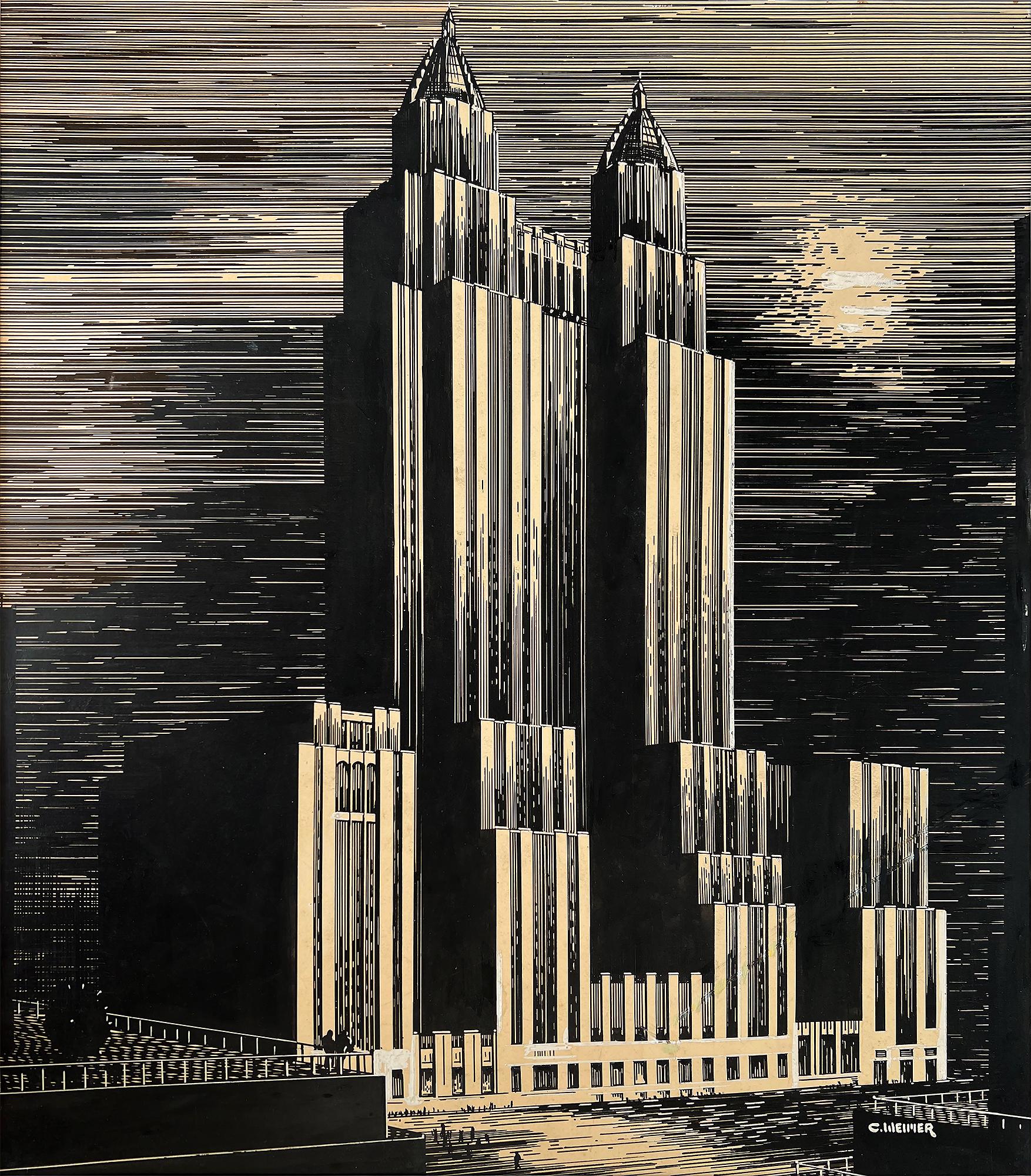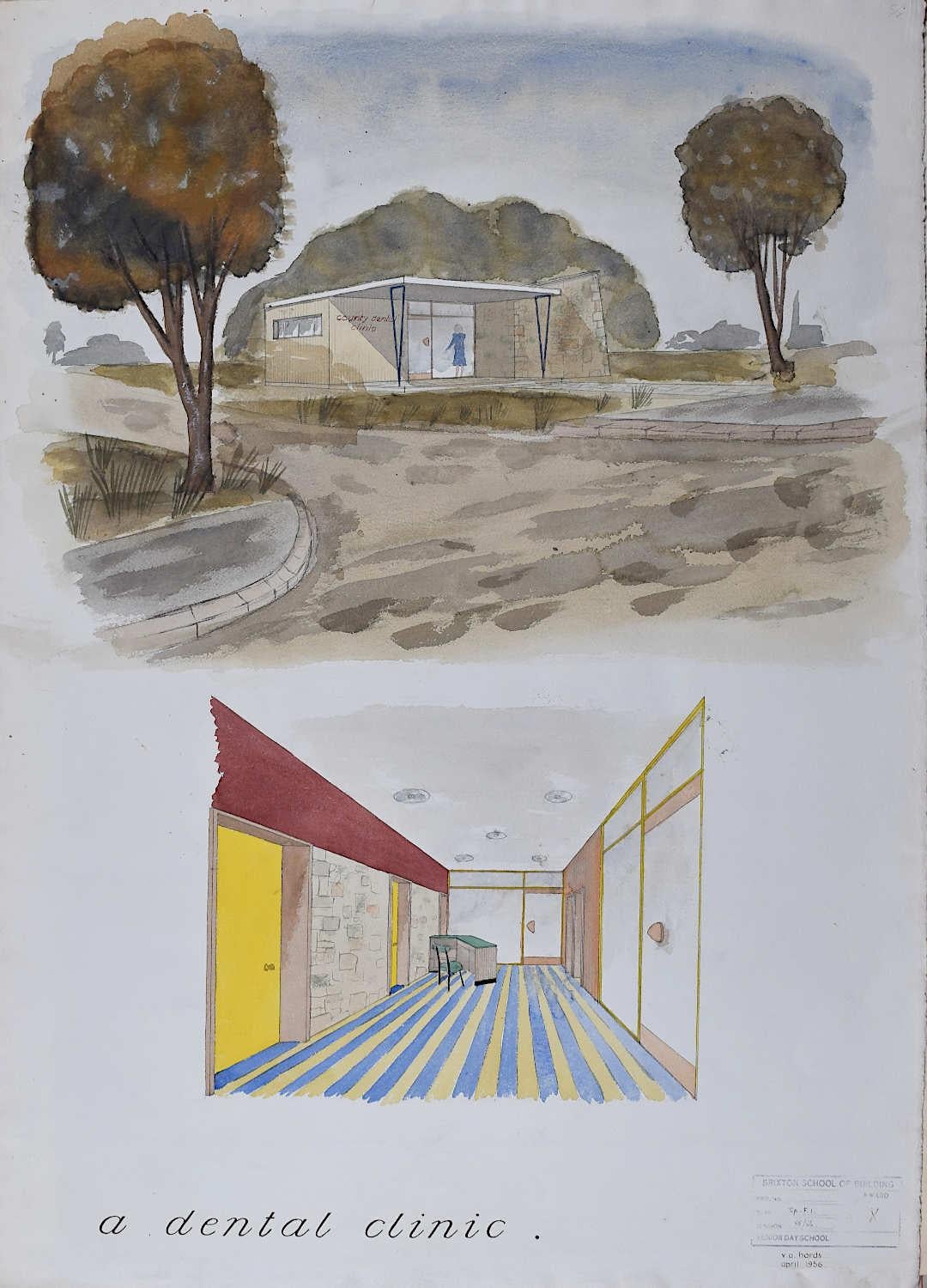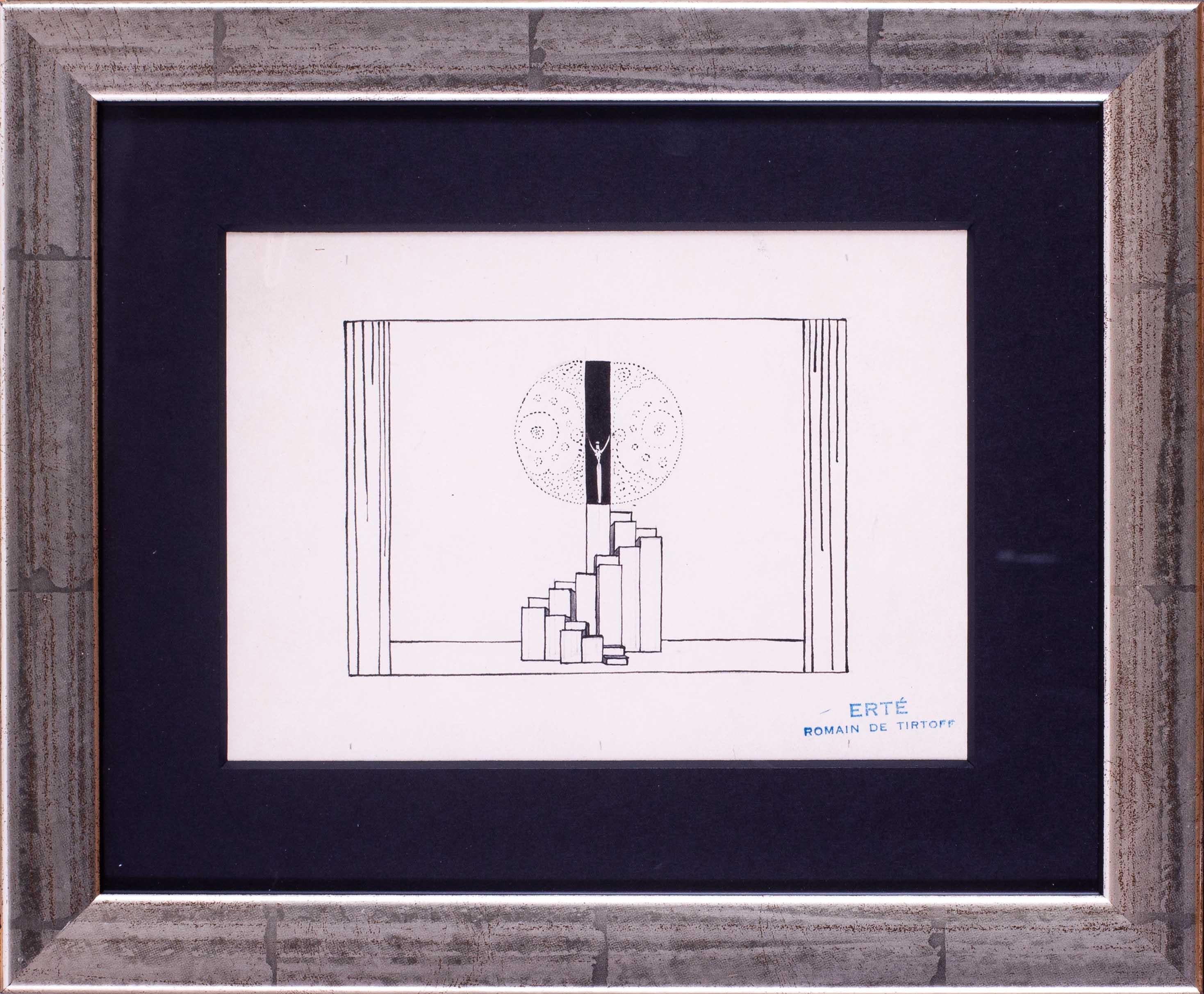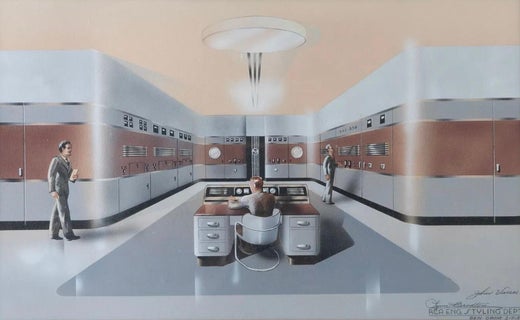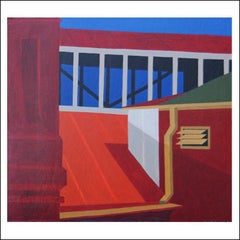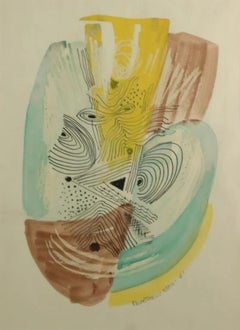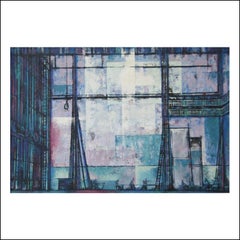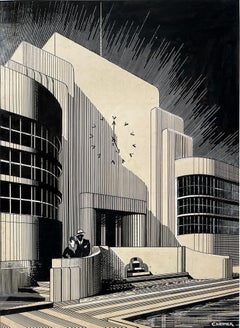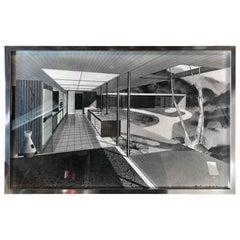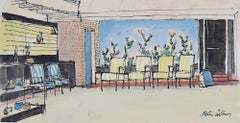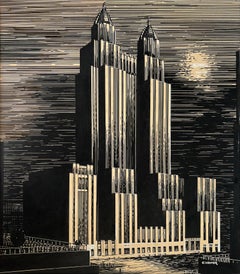Items Similar to RCA Design Art Deco Streamline Mid Century Modern American Scene Architectural
Want more images or videos?
Request additional images or videos from the seller
1 of 8
John VassosRCA Design Art Deco Streamline Mid Century Modern American Scene Architectural1939
1939
$12,000
£9,048.03
€10,465.37
CA$16,977.52
A$18,509.21
CHF 9,779.91
MX$227,619.68
NOK 121,605.27
SEK 114,475.25
DKK 78,125.90
About the Item
RCA Design Art Deco Streamline Mid Century Modern American Scene Architectural
John Vassos (1898-1985)
RCA 50 D Transmitter and Control Desk
12 x 19 1/2 (sight)
Mixed media on board
Signed lower right by Vassos and Lynn Brodton
inscribed RCA Eng. Styling Dept., Ben Grim 2-7-39
Mounted in original Art Deco frame, 19 1/4 x 26 3/4 inches
Depicting the original design for RCA 50 D Transmitter and Control Desk in 1939, designed by Vassos along with industrial designer Lynn Brodton
BIO
John Vassos was an original. It's hard to say that about too many artists as one can usually trace a stylistic path back to an earlier influence. I'm not sure he had one. The only source I can imagine is the technique of display cards that were ubiquitous during his youth and to which he applied his skills soon after he reached New York.
Born in Greece in 1898, he spent his youth in Constantinople where he was artistically active from an early age. He was the editorial cartoonist for a liberal newspaper in his early teens and when one of these cartoons featured a less-than-flattering view of the Turkish senate (he was Greek after all), he was forced to flee (supposedly for his life) on a British ship. He was 16.
World War I had just begun. Vassos saw action in the North Sea, at Gallipoli and on a mine sweeper. He ended up in America in 1919 in Boston. He soon was lettering placards and price tags and going to Fenway Art School at night. One of his instructors was John Singer Sargent. He spent some time as an assistant to Joseph Urban, the man who designed the famous Ziegfeld Follies. Vassos assisted on stage designs for the Boston Opera Company and designed promotional material for Columbia Records in the early Twenties.
He moved to New York in 1924 and opened his own studio, accepting any and all assignments. In his free time he attended the Art Students League and studied under George Bridgman, John Sloan and others. His modern and unique style was put to use on window displays for Macy's and murals for two large movie palaces. This led to advertising work for New York firms like Cammeyer shoes and Bonwit Teller specialties. A preliminary study for a 1924 General Tires ad is at right. A restrained palette and a strong sense of design made his work stand out from the other commercial artists who were trying to synthesize a new, modern style to replace the staid Victorian approach of the previous 25 years. This was, after all, the nineteen twenties!
It was in designs for the theatre that Vassos' style was finalized. The typical overly-ornate, rococo elements of the turn-of-the-century stage and theatre were overlaid with the modern, Art Deco sensibilities of the Twenties. (Art Deco is an abbreviation of Exposition Internationale des Arts Decoratifs et Industriels Modernes, the 1925 French exposition in Paris that celebrated the new, bold, streamlined style in art and appliances.) The shape was important! Whether it was the tall, rectilinear silhouette of a skyscraper or the simple arc from an artist's French curve, the details were muted and the outline carried the pertinent information to the viewer. An unused Vassos design for a theatre curtain (above right) for a 1926 Billy Rose musical is a perfect example. Vassos took the b&w opaque watercolors that he'd used for price placards a few years earlier and developed his startling and powerful approach that was unlike anything being done. It was an immediate (to use another modern word) hit.
More advertising work followed - this time for national firms like Packard Automobiles and French Line cruise ships. The next step for this most "modern" of artists was simple - Industrial Design. After all, the concept of Art Deco was an offshoot of the William Morris notion of a marriage of art with industry. If wallpaper and drapes and windows could be art, why not cars and radios? And, since these were the most modern of times, why not juke boxes and fountain pens? He designed a face-lotion bottle that had one of the very first screwtop caps, just in time for Prohibition. Sales jumped. As the nation grew more crowded, he designed the ubiquitous turnstile to keep some semblance of order in our public lives.
In 1926, he was asked to create a cover illustration for a stage production of Oscar Wilde's Salome. It was seen by an editor at the publishing house of E.P. Dutton and he commissioned a book from Vassos utilizing his distinct style. Salome was published in 1927 using a special printing technique called the Knudson Process. [I won't go into detail about it as there is an excellent contemporary article from a 1928 Penrose Annual available from Peter D. Verheyen on his Vassos site - see References below.] The difference between modern reproductive capabilities and this earlier patented technique are demonstrated below in a portion of an image (at left) from the first limited edition of Salome and the same portion from the 1976 Dover book, Contempo, Phobia and other Graphic Interpretations. This latter book (from which most of the images and information in this page are taken) reproduced Vassos' original paintings using photo-offset printing. You decide which is the most apropos.
- Creator:John Vassos (1898 - 1985, American)
- Creation Year:1939
- Dimensions:Height: 20 in (50.8 cm)Width: 27 in (68.58 cm)
- Medium:
- Movement & Style:
- Period:
- Condition:
- Gallery Location:New York, NY
- Reference Number:1stDibs: LU1156215272672
John Vassos
John Vassos was a singularly unique inventor, industrial designer, artist and illustrator. He also appeared in the E.P. Dutton.
About the Seller
5.0
Gold Seller
Premium sellers maintaining a 4.3+ rating and 24-hour response times
Established in 2008
1stDibs seller since 2019
195 sales on 1stDibs
Typical response time: <1 hour
- ShippingRetrieving quote...Shipping from: Pawling, NY
- Return Policy
Authenticity Guarantee
In the unlikely event there’s an issue with an item’s authenticity, contact us within 1 year for a full refund. DetailsMoney-Back Guarantee
If your item is not as described, is damaged in transit, or does not arrive, contact us within 7 days for a full refund. Details24-Hour Cancellation
You have a 24-hour grace period in which to reconsider your purchase, with no questions asked.Vetted Professional Sellers
Our world-class sellers must adhere to strict standards for service and quality, maintaining the integrity of our listings.Price-Match Guarantee
If you find that a seller listed the same item for a lower price elsewhere, we’ll match it.Trusted Global Delivery
Our best-in-class carrier network provides specialized shipping options worldwide, including custom delivery.More From This Seller
View AllThe New Cable British Modern Mid 20th Century Vorticist European Vorticism Woman
By Sybil Andrews
Located in New York, NY
The New Cable British Modern Mid 20th Century Vorticist European Vorticism Woman
Sybil Andrews CPE (British/Canadian, 1898-1992)
"The New Cable," 1931
12 x 16 1/2 inches
Color linocut
Signed, titled, inscribed 'Second State', and numbered 13/60 in pencil
Framed: 19 x 24 inches
Literature: Coppel Sa17
Illustrated on page 10 of the catalog
The proposed edition of the first state of the Giant Cable was 50, but only 30 impressions were pulled. Andrews removed the blue background for the second state, which was published under the title The New Cable in an edition of 60.
BIO
Sybil Andrews was a printmaker, painter, graphic artist and educator who was born in Bury St. Edmonds, Suffolk, England. She moved to London (England) in 1922. In 1947, she emigrated to Campbell River (Vancouver Island) British Columbia, Canada, where she worked, taught and lived for the rest of her life. She died at a hospital in Victoria (B.C.)
Her mediums were the colour linocut (1) (most famous), etching, posters, pastels, ink, watercolour, monoprint and oil. Her subjects were human activity (at work, sports, travel, etc.), figures, animals, genre, allegory, architecture and landscape. Her style was Art Deco (see AskART styles), Futurism, Cubism and Vorticism (2). Her work is identified by a simple format, clean lines, distortion, vivid colours, drama and rhythm.
Quote: "The colour linocut was just the medium for me, being interested in dynamics and ideas and patterns... It is impossible to be fussy with lines, you have to simplify, you are forced to simplify your idea to its fundamentals." Andrews produced 76 linocuts in her life, of which 43 were made from 1929 to 1939, which is considered to be her best period.
John Hassall's art correspondence course (1918) was the beginning of her formal art education. She went from there to Heatherley's School of Fine Art (London/1922) where she studied under Henry Massey (see AskART) and met artistic partner Cyril Power (see AskART). At the same time, she studied independently with sculptor Henri Glicenstein (see AskART) who taught her drypoint etching and to draw from life.
She also attended the Grosvenor School of Modern Art (1925). Iain McNab (1890-1967) was Principal and Claude Flight (3) (see AskART) an instructor who had a great influence on her choice of linocut as a primary medium. Some of his other students and her associates were Edith Lawrence (1890-1973), Lill Tschudi (1911-2001), Eileen Mayo (see AskART) and William Greengrass (1896-1970). After emigrating to Canada she taught art continuously until a month before her death.
She was elected a member of the Canadian Painters - Etchers Society (after 1976 the Print and Drawing Council of Canada) in 1951.
She began exhibiting her work in 1921.In 1929 she was included in "The First Exhibition of British Linocuts...
Category
1930s Modern Figurative Prints
Materials
Linocut
"Library" Mid 20th Century Precisionism Cubist Realism Modernism Architectural
Located in New York, NY
"Library" Mid 20th Century Precisionism Cubist Realism Modernism Architectural. Signed verso.
Robert Herrmann hid his paintings from the public for ov...
Category
1960s Modern Landscape Paintings
Materials
Oil, Board
Abstract American Modernism Mid-Century WPA Era Drawing Woodstock 20th Century
By Konrad Cramer
Located in New York, NY
Abstract American Modernism Mid-Century WPA Era Drawing Woodstock 20th Century, Sight size is 16 x 12 inches. The drawing is currently at the framers. A photo will be posted asap.
A...
Category
1930s Abstract Abstract Drawings and Watercolors
Materials
Paper, Ink, Watercolor
"Backstage, Ambassador" Broadway Theatre NYC Mid-century Modern Modernist Cubist
By Sam Norkin
Located in New York, NY
"Backstage, Ambassador" Broadway Theatre NYC Mid-century Modern Modernist CubistSigned lower left, titled on the stretcher.
Norkin was a Brooklyn, Ne...
Category
1940s American Modern Interior Paintings
Materials
Canvas, Oil
Abstract Work on Paper Mid-Century Modernism Greek American Gouache Drawing
By Jean Xceron
Located in New York, NY
Abstract Work on Paper Mid-Century Modernism Greek American Gouache Drawing.
A modernist artist who emigrated to America from Greece in 1904, when he was fourteen years old, Jean Xceron is described as having a reputation as an artist that has mysteriously fallen into obscurity---especially since he was reportedly quite prominent during his lifetime. However, a partial explanation of that omission is the fact that many of his papers and early records have been lost. He was a painter of biomorphic abstractions and did collages, which were influenced by Dadaism.
Xceron was active in New York City when modernism was gaining influence. Of him during this period, it was written that his artistic role was "a vital link between what is commonly termed as the first-generation (the Stieglitz group, the Synchromists, etc.) and second-generation, the American Abstract Artists, the Transcendental Painting...
Category
1940s American Modern Abstract Drawings and Watercolors
Materials
Paper, Gouache
Abstract Cityscape Mid 20th Century Modern Cubist Work on Paper Drawing Ariel
By Clarence Holbrook Carter
Located in New York, NY
Abstract Cityscape Mid 20th Century Modern Cubist Work on Paper Drawing Ariel
11 x 4 1/2 inches. Framed by Heydenryk.
Provenance: Gary Snyder Fine Art
B...
Category
1950s Abstract Abstract Drawings and Watercolors
Materials
Paper, Gouache
You May Also Like
Art Deco Couple In Front of Black and White Art Deco Architecture
Located in Miami, FL
Art Deco Illustrator Charles Perry Weimer creates a powerfully graphic depiction of a 1930s couple in front of a classic Art Deco building with a...
Category
1930s Art Deco Landscape Drawings and Watercolors
Materials
Paper, Ink
Stunning Modernist Architectural Rendering, Drawing by G.F.Hahn
Located in Buffalo, NY
Original MCM Pen and ink architectural study for a Palm Springs Residence (unbuilt). Framed and signed; J.H.Hahn, Reminiscent of the famed Dinah Shore hous...
Category
Mid-20th Century American Mid-Century Modern Paintings
Materials
Lead
Peter Collins ARCA Mid Century Modern Lounge Interior Modernist House Home
By Peter Collins ARCA
Located in London, GB
To see our other Modern British Art, scroll down to "More from this Seller" and below it click on "See all from this Seller" - or send us a message if you cannot find the artist you ...
Category
1950s Modern Landscape Drawings and Watercolors
Materials
Ink, Watercolor
Waldorf Astoria Art Deco Illustration
Located in Miami, FL
Artist Charles Perry Weimer employs thin black horizontal lines that intersect with thin black vertical lines. The result is a triumph of design w...
Category
1930s Art Deco Landscape Drawings and Watercolors
Materials
Ink, Gouache, Pen
Design for Modernist Dental Surgery architectural drawing Mid Century Modern
Located in London, GB
To see our other Architectural Drawings, scroll down to "More from this Seller" and below it click on "See all from this Seller."
V A Hards (British, c. 1930-c. 2012)
Design for Mod...
Category
1950s Modern Interior Drawings and Watercolors
Materials
Watercolor
Romain de Tirtoff, called Erte, Art Deco theatre set design in ink
By Erte - Romain de Tirtoff
Located in Petworth, West Sussex
Romain de Tirtoff, called Erte (French/Russian, 1892-1990)
Décor pour une entrée des danseuses
Ink pen
Signed with studio stamp (lower right)
5 x 7 in. (12.8 x 17.8 cm.)
Provenance :...
Category
20th Century Art Deco Interior Drawings and Watercolors
Materials
Ink
Read More
Al Hirschfeld’s Take on Judy Garland Stands out among His Many Love Letters to Broadway
The revered artist created delightful caricatures of stage and screen performers for more than 75 years. This one is a prime example.
Ludwig Bemelmans Captures the Thrilling Sight of Coney Island at Night
The ‘Madeline’ creator and Carlyle Hotel legend was in a New York state of mind in the 1940s when he produced this exuberant and rare oil painting.
More Ways To Browse
Mid Century Modern Architecture Painting
Modern Architecture Art
Theatre Design
Streamline Art Deco
British Ships
Vintage Macys
Vintage Bonwit Teller Vintage
1930 Streamline Art Deco
American Art Deco Painting
Mid Century Architectural Drawing
Vintage Art Deco Interior Design
Ziegfeld Follies
Framed Architectural Drawings
Vintage Ziegfeld Follies
Juke Box
Used Juke Boxes
Vintage Transmitter
Vintage Juke
